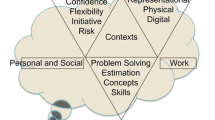Every sane person lives in a double world, the outer and the inner world…Charles S. Peirce (1931–1958, Vol. 5, P.487)
Abstract
The comments below are meant to show that considerations of public and private realms and the tension between these realms arise in a natural and persistent way in discussions connected with semiotics. In particular, they arise out of the themes of body and sociocultural mathematical meaning-making, which are recurring themes of the papers in this volume. The public–private dichotomy is related to other dichotomies such as those between outer and inner and collective and individual. For educators, such dichotomies are important in that they reflect the division between students' own inner and individual understandings of mathematical ideas and their functioning within a shared sociocultural world of mathematical meanings.
Similar content being viewed by others
Notes
One might also take this as an instance of Peirce's “secondness,” and the thoughts arising from it Peirce's “energetic interpretant,” but I will not pursue this.
References
Carruthers, M. (1990). The book of memory: A study of memory in medieval culture. Cambridge: Cambridge University Press.
Peirce, C. S. (1931–1958). Collected papers, 8 vols. Cambridge: Harvard University Press.
Eco, U. (1986). Semiotics and the philosophy of language. Bloomington: Indiana University Press.
Fried, M. N. (2007). Didactics and history of mathematics: Knowledge and self-knowledge. Educational Studies in Mathematics, 66(2), 203–223.
Fried, M. N. (2008). Between public and private: Where our mathematical selves reside. In L. Radford, G. Schubring, & F. Seeger (Eds.), Semiotics in mathematics education: Epistemology, history, and culture (pp. 121–138). Rotterdam: Sense Publishers.
Fried, M. N., & Amit, M. (2003). Some reflections on mathematics classroom notebooks and their relationship to the public and private nature of student practices. Educational Studies in Mathematics, 53(2), 91–112.
Fried, M. N., & Amit, M. (2008). The co-development and interrelation of proof and authority: The case of Yana and Ronit. Mathematics Education Research Journal, 20(3), 54–77.
Husserl, E. (1936). The origin of geometry’ (D. Carr, trans.), (1989). In J. Derrida (Ed.), Edmond Husserl’s origin of geometry: An introduction (pp. 155–180). Lincoln: University of Nebraska Press.
Johnson, M. (1987). The body in the mind: The bodily basis of meaning, imagination, and reason. Chicago: University of Chicago Press.
Klein, J. (1985). Phenomenology and the history of science. In R. B. Williamson & E. Zuckerman (Eds.), Jacob Klein: Lectures and essays (pp. 65–84). Annapolis: St. John’s College Press.
Lakoff, G., & Nuñez, R. (2000). Where mathematics comes from: How the embodied mind brings mathematics into being. New York: Basic Books.
Nancy, J. L. (1993). The birth to presence. Stanford: Stanford University Press.
Patterson, J. W., & Zarefsky, D. (1983). Contemporary debate. Boston: Houghton Mifflin.
Plato, A. (1899–1906). In J. Burnet (Ed.), Opera, 5 vols. Oxford: Clarendon.
Ulam, S. M. (1983). Adventures of a mathematician. New York: Charles Scribner’s Sons.
Vygotsky, L. S. (1978). In M. Cole, V. John-Steiner, S. Scribner, & E. Souberman (Eds.), Mind in society: The development of higher psychological processes. Cambridge: Harvard University Press.
Author information
Authors and Affiliations
Corresponding author
Rights and permissions
About this article
Cite this article
Fried, M.N. Signs for you and signs for me: the double aspect of semiotic perspectives. Educ Stud Math 77, 389–397 (2011). https://doi.org/10.1007/s10649-011-9319-0
Published:
Issue Date:
DOI: https://doi.org/10.1007/s10649-011-9319-0



